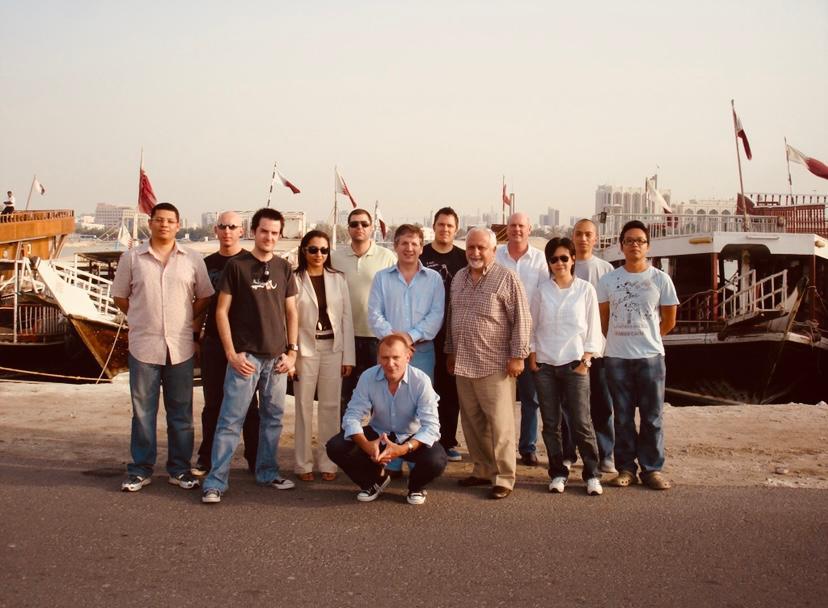On 15 May 2008, TBWA\RAAD assembled a team of its senior executives under the leadership of Marie Jamieson, group executive director of TBWA\Hunt\Lascaris in South Africa, and Rafic Kamaleddine, head of strategic planning at our regional headquarters in Dubai. The team was to conduct a Disruption Day for Qatar Foundation. This step was made necessary by the fact that no one at Qatar Foundation was able to give us a proper brief, although they still wanted to deliver Sheikha Moza’s dream of making her foundation as globally famous and popular as Apple.
At the Sheraton hotel in Doha, we met all the foundation’s senior executives, including the financial, human resources and legal people. We were also introduced to senior executives representing the eight American universities operating within Qatar Foundation campus. We quickly realized that getting all these fine individuals to agree and commit to a joint vision was going to be a very challenging task.
Early in the day, the representatives of the eight universities joined forces to complain that Sheikha Moza should have called them to discuss their point of view in relation to the foundation, before wasting time and money on appointing an advertising agency. However, as the day progressed, attitudes began to change. We at TBWA had put a lot of effort into collating information and reference material that animated the boards that showed the details of the four main conventions including the operations of many social, welfare, cultural and non-governmental foundations around the world. By the early evening, all the participants agreed on the fact that Qatar Foundation had been established on the premise of a deeply entrenched belief that every human being is born with potential that is waiting to be unlocked. The foundation would have to use its three pillars of education, science, and research, supported by community development, to promote people’s abilities through investment in human capital. This was summarized in a vision that encapsulated the above thought in a single statement:
Qatar Foundation unlocks people’s potential.
Since Lee Clow was unable to come to Qatar, we agreed with the foundation’s management to embark on a SWAT workshop. This methodology – which had been introduced by TBWA Worldwide’s creative director, John Hunt – called on the global network’s additional creative power to help with creative development. Any given SWAT team works for up to a week until it arrives at a big idea, which is then presented to the client. Our pledge to Sheikha Moza was that John Hunt would liaise with Lee Clow daily, so that the final concept would carry the signature of Lee Clow before it was presented to the First Lady.
The Qatar Foundation SWAT team included Ben Scheer and Uwe Gluesing from TBWA\Hamburg; Drew Stalker and Alan Manasay from TBWA\Chiat\Day in Los Angeles; Simon Chew and Justine Lee from TBWA\Singapore; Wechan Mecrholz and Dan Parmenter from TBWA\Hunt\Lascaris in South Africa. The team also included Malek Atassi and Saadi Al Kouatli from TBWA\RAAD Middle East.
On the first day after the team’s arrival in Doha, the client took us all on a tour of its large campus, which it referred to as Education City. Each of the eight universities had planned a guided tour on their own mini campuses. We were also taken around the landmarks of Doha, including the Museum of Islamic Art, Souk Waqif, and the Doha Corniche.
The SWAT event was scheduled to take a full week, and on the third morning I noticed the door of the conference room was slightly ajar, allowing someone to peep inside. I dashed to the door to find Haya Al Nasr and her executive assistant, Mayan Zebib, checking to see (at the instructions of the foundation’s admin people) whether the six creative units were really working. Someone within the client’s traditional management had questioned the need for all these rooms.
The first few days of brainstorming led to the development of a powerful campaign manifesto, that said:
“Think.
Few things possess more Power than a Thought.
Because a Thought has the potential to become something significant. To solve something meaningful and to inspire us to achieve great things.
What makes a Thought so powerful is that it can be created by anybody at anytime from anywhere.
That’s why Thinking should be encouraged and nurtured in all its forms. No matter how small or how impossibly grand.
Because wherever Thinking happens, Big Ideas follow. Minds become enlightened, knowledge grows, and people discover new ways to unlock their potential.
So, start thinking.”
This manifesto was then interpreted into three different campaigns that were presented to Haya Al Nasr and her management team on Friday evening. All three were highly complimented, but we were told that only Sheikha Moza would decide which was to be used when we presented to her the following morning.
On Saturday, Haya Al Nasr came to me and John Hunt requesting the entire team extend their stay for one more week as the First Lady was busy. We had to explain that each of these creative directors had loads of additional responsibilities at the agencies where they were employed. They were kind to come and help but it was impossible to keep them in Doha any longer. So, they all left on the understanding that they would have to return when Sheikha Moza became available to review the work.
